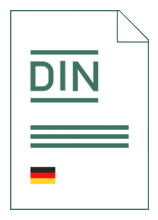Standards Worldwide
Standards Worldwide
Phone +49 30 58885700-07

Technical rule [NEW]
DIN DKE SPEC 99100:2025-02
Requirements for data attributes of the battery passport; Text in English
- German title
- Anforderungen an Datenattribute des Batteriepasses; Text Englisch
- Publication date
- 2025-02
- Original language
- English
- Pages
- 106
- Procedure
- PAS
- Publication date
- 2025-02
- Original language
- English
- Pages
- 106
- Procedure
- PAS
- DOI
- https://dx.doi.org/10.31030/3582101
Product information on this site:
Quick delivery via download or delivery service
Buy securely with a credit card or pay upon receipt of invoice
All transactions are encrypted
Loading recommended items...
Loading recommended items...
Loading recommended items...
Loading recommended items...
